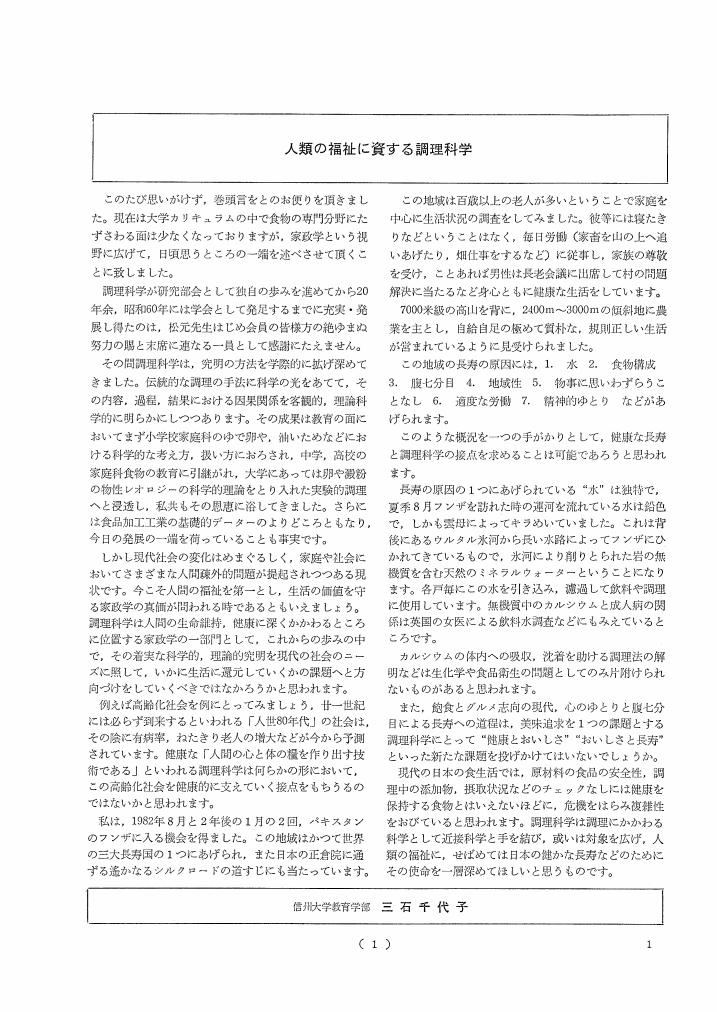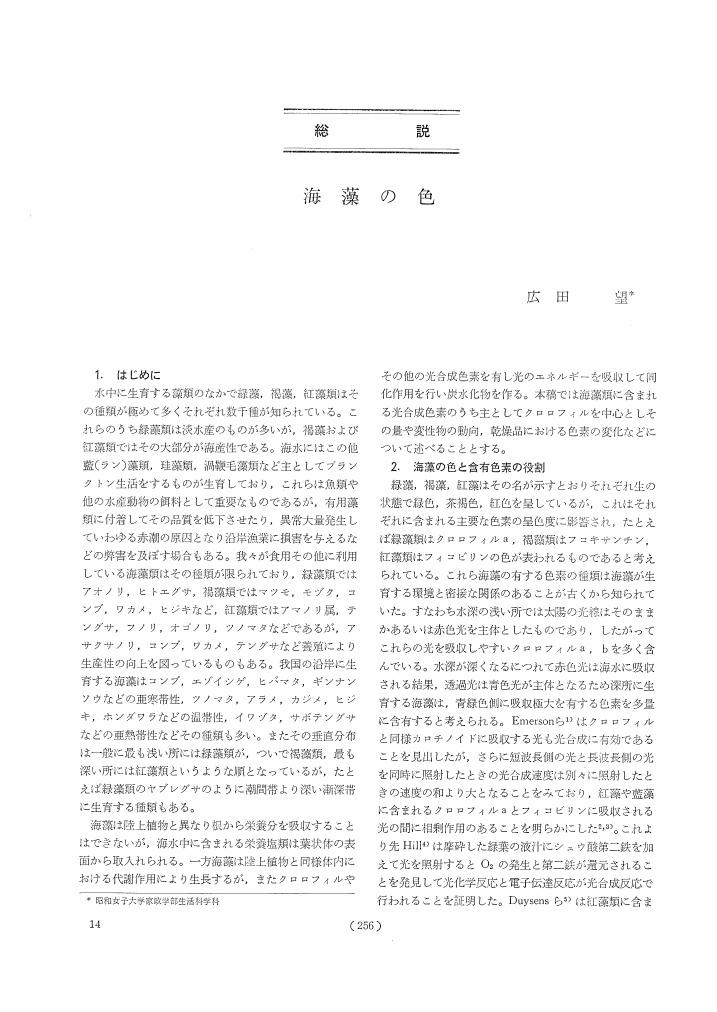1 0 0 0 OA 炊飯にともなうコメの理化学的変化に関する研究
- 著者
- 森 雅央
- 出版者
- 一般社団法人 日本調理科学会
- 雑誌
- 調理科学 (ISSN:09105360)
- 巻号頁・発行日
- vol.9, no.3, pp.142-149, 1976-09-20 (Released:2013-04-26)
- 被引用文献数
- 2
1 0 0 0 OA 16世紀から17世紀における菓子について
- 著者
- 江後 迪子 山下 光雄
- 出版者
- 一般社団法人 日本調理科学会
- 雑誌
- 日本調理科学会誌 (ISSN:13411535)
- 巻号頁・発行日
- vol.30, no.2, pp.106-113, 1997-05-20 (Released:2013-04-26)
- 参考文献数
- 35
The Japanese sweets which appeared intherecord of the 16th and 17th century were studied by employing the literature “Onari” and “Chakai” from the 16th to the 17th and “The Menu of Chosentsusinsi”. The introduction of the processed sweets and the historical changes of the sweets were investigated.The result showed that nuts and fruits were popular in the 16th century, while the processed sweets and Nanban sweets were increased in quantity and variety. It was greatly influenced by the entertainment of Chosentsusinsi.
1 0 0 0 鰹節のだし汁に関する研究(第1報):水だしについて
- 著者
- 武田 たつ代 吉松 藤子
- 出版者
- 一般社団法人 日本調理科学会
- 雑誌
- 日本調理科学会誌 (ISSN:09105360)
- 巻号頁・発行日
- vol.14, no.1, pp.49-54, 1981
鰹節の水だし汁のとり方について浸出温度,時間と試料形態について検討した結果は次のようであった.<BR>1.浸出温度20℃ では,粉砕のもので16時間,薄片状で20時間,5℃ では,いずれも32時間で旨味成分の浸出量が最高に達することが認められた.<BR>2.各成分の浸出量は,時間の経過に伴って増加したが一定時間の後は減少した.従って過度の浸出時間は,かえってマイナスになる.<BR>3,だし汁の採取量は,自然湧過では薄片状の方が,吸引游過では粉砕のものの方が,より多く得られた.<BR>4.5'-AMPの浸出量は一定時間の経過後に減少し入れかわりに5'-IMPが増加した.<BR>5.各成分の浸出量は10~30分の浸出でも,かなり高く5'-AMPは煮だし汁の66~77%,5'-IMPは80%であった.<BR>6.水だし汁(最高の浸出条件)と煮だし汁の5'-AMP,5'-IMPの浸出率を比較すると5'-IMPでは煮だし汁は鰹節中の含有量の約70%であり,水だし汁は煮だし汁の約光であった.5'-IMPについては両者間に大きな差はなく約80~90%であった.
1 0 0 0 OA 食品の苦味成分
- 著者
- 萩原 清和
- 出版者
- 一般社団法人 日本調理科学会
- 雑誌
- 調理科学 (ISSN:09105360)
- 巻号頁・発行日
- vol.13, no.1, pp.21-26, 1980-04-30 (Released:2013-04-26)
- 参考文献数
- 39
- 被引用文献数
- 1
1 0 0 0 OA 調味液中での加熱に伴うイカ肉のテクスチャー変化
- 著者
- 香川 実恵子 松本 美鈴 畑江 敬子
- 出版者
- 一般社団法人 日本調理科学会
- 雑誌
- 日本調理科学会誌 (ISSN:13411535)
- 巻号頁・発行日
- vol.39, no.3, pp.215-226, 2006-06-20 (Released:2013-04-26)
- 参考文献数
- 31
- 被引用文献数
- 1
Mieko Kagawa Misuzu Matsumoto Keiko Hatae The changes in the food texture of squid muscle boiled in water (WA), an 18% salt solution (SA), and 100%soy sauce (SO) for 1,5,10, and 30 min were investigated by a sensory evaluation of the texture and measurements of the total weight, moisture content, salt concentration, pH value, mechanical properties, and protein composition. The samples cooked in SO had the highest hardness, followed by the samples in SA and then those in WA. Longer boiling in WA made the meat softer, but had no such effect on the samples boiled in SA and SO. The moisture content of the muscle boiled in SA and SO decreased with increasing boiling time, particularly so in SO. The results from the sensory evaluation of the texture, mechanical properties, and protein composition analysis show different textural properties of the muscle samples boiled in SO from those in SA. Boiling in SO for a short time made the skin tough. It seems that some components in SO other than sodium chloride influenced the physical properties of the muscle and skin of the squid.
1 0 0 0 OA 人類の福祉に資する調理科学
- 著者
- 三石 千代子
- 出版者
- 一般社団法人 日本調理科学会
- 雑誌
- 調理科学 (ISSN:09105360)
- 巻号頁・発行日
- vol.21, no.1, pp.1, 1988-06-20 (Released:2013-04-26)
- 被引用文献数
- 1
1 0 0 0 OA 駅売弁当について
- 著者
- 山崎 きく子
- 出版者
- 一般社団法人 日本調理科学会
- 雑誌
- 調理科学 (ISSN:09105360)
- 巻号頁・発行日
- vol.9, no.1, pp.19-24, 1976-04-10 (Released:2013-04-26)
- 参考文献数
- 3
1 0 0 0 五島牛肉の食味性について(第2報)
- 著者
- 塩田 教子
- 出版者
- 一般社団法人 日本調理科学会
- 雑誌
- 調理科学
- 巻号頁・発行日
- vol.21, no.3, pp.195-200, 1988
It had been reported that characteristics of the physical properties of Goto beef were compared with frozen beef and another beef produced in Nagasaki prefecture. In this report, the relationship between sensory evaluations and physicochemical properties in the cooked beef and in the extractliquid is observed. The cooked beef was prepared by heating round beef to medium on the hotplate. The extract-liquid was prepared by boiling round beef for 2 hrs. Physicochemical properties of the extract-liquid such as acidity, color characteristics, total extractive, inorganic extractive, organic extractive, total-N, proteide-N, formol-N, free amino acid, succinic acid, lactic acid,5'-AMP and 5'-IMP were measured.<br>The results obtained were as follows:<br>1) Extract-liquid of Goto beef showed better taste, mildness and savory aroma.<br>2) Total extractive, organic extractive, total-N, proteide-N, formol-N, in the extract-liquid were a little higher than those of the another beef and those of the frozen beef were the highest.<br>3) Total content of free amino acid and succinic acid in the extract-liquid were lower than those of frozen beef but the 5'-IMP was higher than that of frozen beef.<br>4) Significant multiple regression coefficients of physicochemical properties obtained from three kinds of cooked beef were: tenderness (p<0.01), elasticity (p<0.01), juiciness (p<0.05), taste (p<0.01), aroma (p<0.01), and overall palatability (p<0.01).<br>5) The physicochemical properties of the extract-liquid were not evaluated by regression analysis.
1 0 0 0 天ぷら油火災の概要と実験結果
- 著者
- 東京消防庁生活安全課
- 出版者
- 一般社団法人 日本調理科学会
- 雑誌
- 調理科学
- 巻号頁・発行日
- vol.18, no.3, pp.194-199, 1985
東京消防庁では昭和60年3月11日表題のような調査結果を発表した.私達にとって参考になるところが多いので,実験結果と天ぷら油火災の概要の一部を抜すいして紹介する.
1 0 0 0 OA 海藻の色
- 著者
- 広田 望
- 出版者
- 一般社団法人 日本調理科学会
- 雑誌
- 調理科学 (ISSN:09105360)
- 巻号頁・発行日
- vol.13, no.4, pp.256-263, 1980-12-20 (Released:2013-04-26)
- 参考文献数
- 60
1 0 0 0 OA 冷凍食品の揚油の劣化について
- 著者
- 鈴木 静子 牧 充子
- 出版者
- 一般社団法人 日本調理科学会
- 雑誌
- 調理科学 (ISSN:09105360)
- 巻号頁・発行日
- vol.7, no.1, pp.50-54, 1974-02-20 (Released:2013-04-26)
- 参考文献数
- 3
1 0 0 0 音響解析による揚げ物の食感評価
- 著者
- 杉山 妙
- 出版者
- 一般社団法人 日本調理科学会
- 雑誌
- 日本調理科学会誌 (ISSN:13411535)
- 巻号頁・発行日
- vol.49, no.3, pp.258-259, 2016
1 0 0 0 OA 箸およびスプーン使用時の利き手と非利き手の比較と箸のトレーニング効果
- 著者
- 立屋敷 かおる 杉田 泰葉 今泉 和彦
- 出版者
- 一般社団法人 日本調理科学会
- 雑誌
- 日本調理科学会誌 (ISSN:13411535)
- 巻号頁・発行日
- vol.38, no.4, pp.350-354, 2005-08-05 (Released:2013-04-26)
- 参考文献数
- 17
- 被引用文献数
- 1
The difference was studied between use of the dominant hand and non-dominant hand in the transfer time of a cotton sample by using chopsticks and a spoon. The effect of training on the transfer time of the cotton sample by chopsticks in the dominant hand and non-dominant hand was also examined. The transfer times of a sample by chopsticks and spoon were significantly shorter when held in the dominant hand than in the non-dominant hand.. The transfer time of a sample in the dominant hand was significantly longer by spoon than by chopsticks. However, no significant difference was apparent in the transfer time of the sample between the chopsticks and spoon in the non-dominant hand. Training in manipulating the chopsticks significantly reduced the transfer time of a sample in the period from 6 to 10 days after starting the training, and this reduced transfer time was maintained 45days after the cessation of training. These results suggest that the hand dominance for using chopsticks was more prominent than that for spoon use and that training for chopstick use was more effective for the non-dominant hand, with the effect being maintained for a long period of time.
1 0 0 0 OA 基本的四味の相互関係について
- 著者
- 浜島 教子
- 出版者
- 一般社団法人 日本調理科学会
- 雑誌
- 調理科学 (ISSN:09105360)
- 巻号頁・発行日
- vol.8, no.3, pp.132-136, 1975-10-20 (Released:2013-04-26)
- 参考文献数
- 13
1 0 0 0 OA 家庭における揚げ調理に関する油の利用状況の実態調査
- 著者
- 伊藤 知子 石津 日出子 井上 吉世 佐久聞 桂子 高村 仁知 中原 満子 西池 珠子 林 淑美 原 知子 深見 良子 藤井 美紗子 的場 輝佳 水野 千恵 村上 恵 椴山 薫 夜久 富美子 湯川 夏子
- 出版者
- 一般社団法人 日本調理科学会
- 雑誌
- 日本調理科学会誌 (ISSN:13411535)
- 巻号頁・発行日
- vol.33, no.2, pp.236-243, 2000-05-20 (Released:2013-04-26)
- 参考文献数
- 19
- 被引用文献数
- 2
A questionnaire survey on the edible oils used for deep frying in the home was conducted in 1998in the Kinki District of Japan.The respondent used an average of three types of edible oil, the most popular combination being salad oil, sesame oil and olive oil. The oil most commonly used for deep frying was salad oil, with safflower and rapeseed oil also being used for this.The criteria applied for buying oil for deep frying were the price, variety and expiration date. The parameters used for determining the life of the frying oilswere, in the order of number of answers, color (light brown), number of times used, smell and foaming property. It was apparent that the criteria for purchase and the frequency of deep frying for home cooking affected the utilization of edible oils for deep frying.These results indicate a perception of health and convenience in the utilization of edible oils for deep frying in home cooking.
1 0 0 0 OA 家庭における食用油の使用と使用したフライ油の廃棄処理
- 著者
- 梶本 五郎
- 出版者
- 一般社団法人 日本調理科学会
- 雑誌
- 日本調理科学会誌 (ISSN:13411535)
- 巻号頁・発行日
- vol.33, no.3, pp.387-391, 2000-08-20 (Released:2013-04-26)
- 参考文献数
- 13
1 0 0 0 温塩水解凍により解凍したマグロ肉の品質
- 著者
- 米田 千恵 粟津原 元子 畑江 敬子
- 出版者
- 一般社団法人 日本調理科学会
- 雑誌
- 日本調理科学会誌 (ISSN:13411535)
- 巻号頁・発行日
- vol.41, no.5, pp.337-343, 2008
冷凍メバチ肉の塊を,30℃ の3%食塩水に浸漬する解凍法(解凍法1),30℃ の水に浸漬する解凍法(解凍法2)および4℃ での緩慢解凍(解凍法3)に供した。品質の同じ試料では,解凍過程における重量変化,色は解凍法1と解凍法2の間で差異はみられなかった。上物とよばれる品質の高いマグロ肉についての官能検査では, 解凍法1 で解凍した試料は解凍法2で解凍したものに比べて,水っぽくなく,一方で,粘性,塩味,マグロらしい味(うま味)が強かった。解凍法1で解凍した刺身の外側の食塩濃度は,解凍法2および解凍法3で解凍した試料の食塩濃度よりも有意に高かった。マグロ肉へ食塩が浸透することによって,粘性が増し,うま味が増強されるものと考えられた。
1 0 0 0 OA オーブン焼成菓子の品質形成要因に関する研究
- 著者
- 大喜多 祥子
- 出版者
- 一般社団法人 日本調理科学会
- 雑誌
- 日本調理科学会誌 (ISSN:13411535)
- 巻号頁・発行日
- vol.48, no.2, pp.79-86, 2015 (Released:2015-05-02)
- 参考文献数
- 51
1 0 0 0 OA 京都商家のくらしと食
- 著者
- 島﨑 とみ子
- 出版者
- 一般社団法人 日本調理科学会
- 雑誌
- 日本調理科学会誌 (ISSN:13411535)
- 巻号頁・発行日
- vol.42, no.4, pp.244-254, 2009 (Released:2015-01-30)
- 参考文献数
- 21
本報告は幕末の京都に住む商人の日記をもとに,暮らしと食を年中行事に絞り,その一端を明らかにしようとしたものである。その結果は,年中行事の中,最も大きな行事は正月であった。彼は日常に交際ある人々を大事に考え,飲食を共にしている。料理は豊富に魚介類が使われ,野菜類は京都近郊の物が多い。また,信仰にもとづく行事では,寺と神社で料理・食品の使い方が区別されていた。行事の扱い方には差違がみられる。敬重に行なわれるもの,簡略化あるいは遊興的に変化したものがあった。
1 0 0 0 OA 貝類の毒
- 著者
- 神谷 久男
- 出版者
- 一般社団法人 日本調理科学会
- 雑誌
- 調理科学 (ISSN:09105360)
- 巻号頁・発行日
- vol.14, no.3, pp.146-151, 1981-10-20 (Released:2013-04-26)
- 参考文献数
- 8









